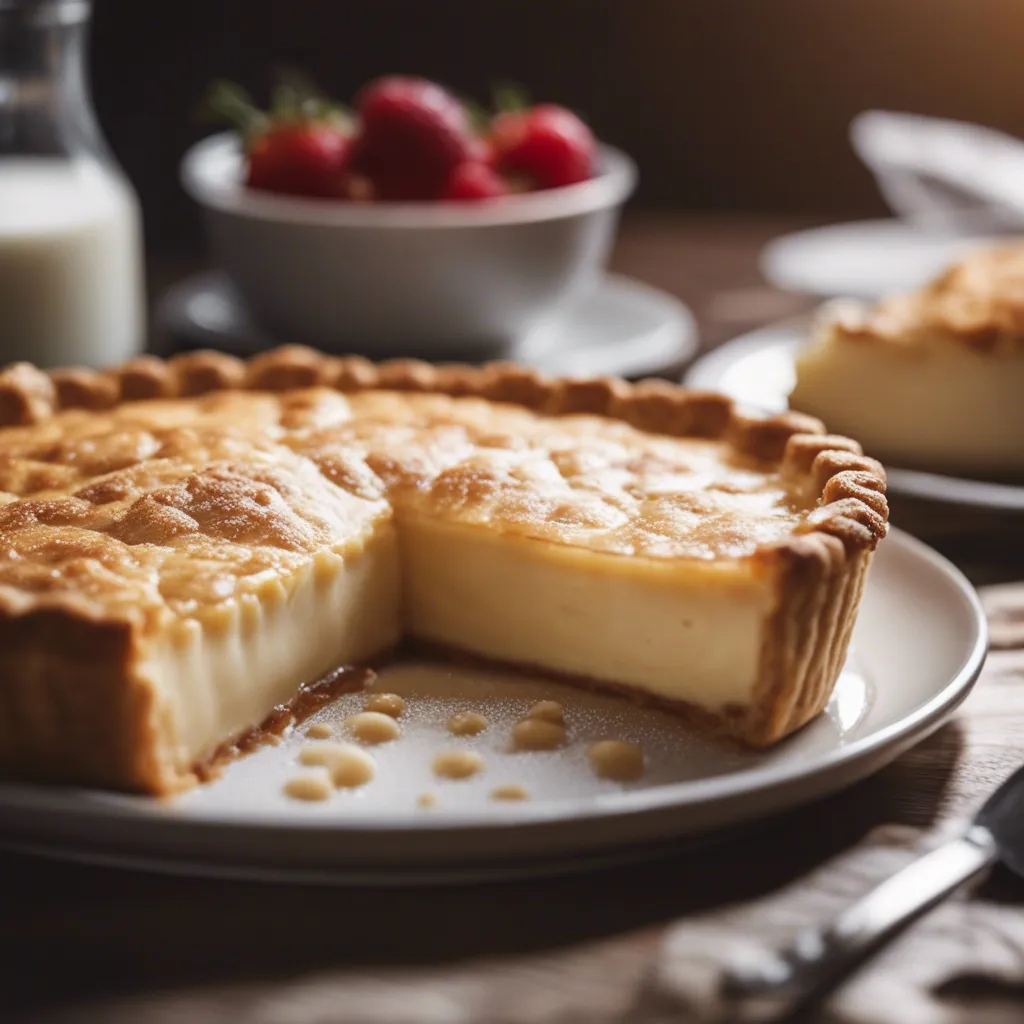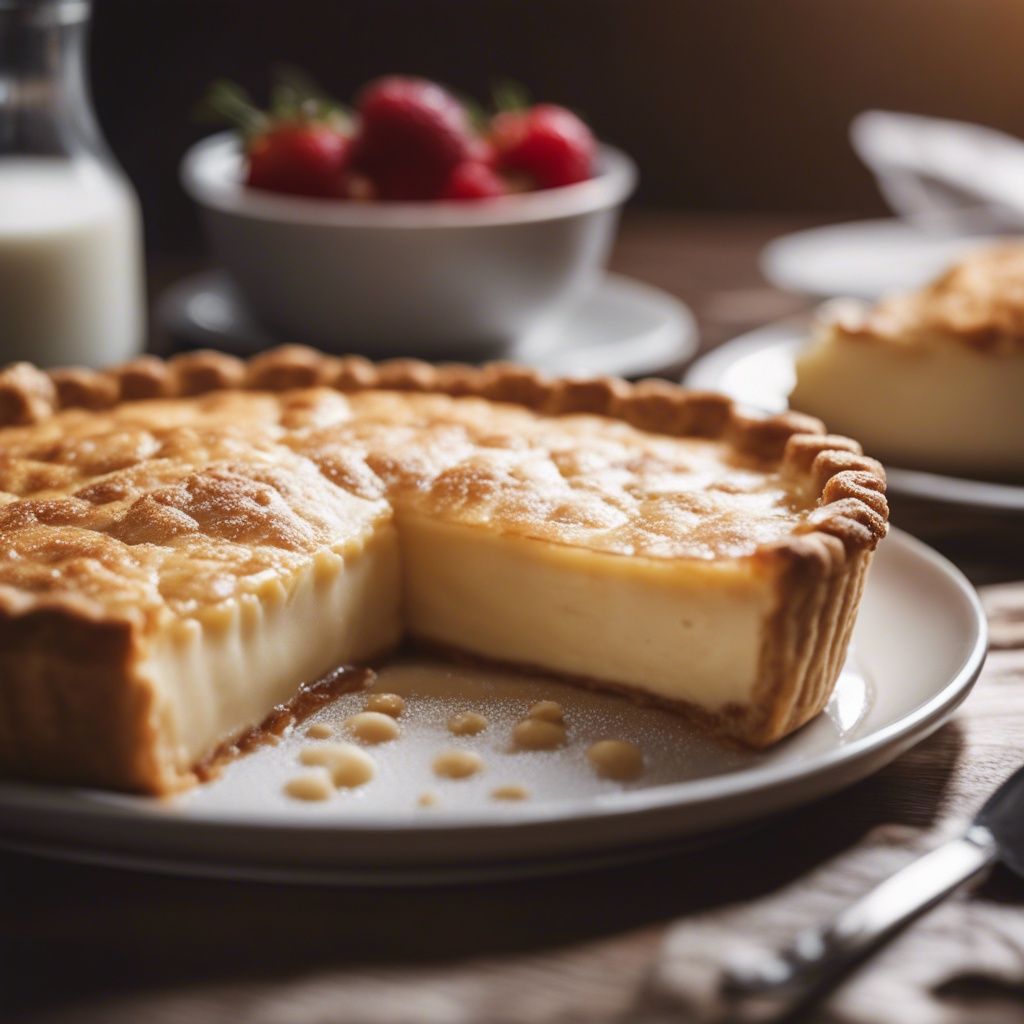Milk Pie
We discovered this recipe recently and can’t get enough of it - the Greek Milk Pie, or as it’s affectionately known in Greece, Galatopita. This rustic treat, steeped in tradition, has charmed its way into our kitchen, and we can’t wait to show you why it’s a must-try.

The beginnings of Galatopita
We stumbled upon Galatopita’s story while exploring the roots of Greek cuisine; it’s a dish born from simplicity and necessity. It was a go-to recipe for many Greek households, especially during religious periods when people would often reduce or refrain from meat and other animal products.
Over time, the recipe evolved, and variations emerged; some versions include filo pastry, while others are crustless, focusing purely on the creamy custard filling. The addition of semolina, vanilla, or even lemon zest in recipes shows the pie’s adaptability depending on the ingredients available.
Greek milk pie is the go-to dessert for celebrations, holidays, and family gatherings because it’s simply comfort on a plate.
Perfect Pairings
This pie is traditionally served with strong coffee, which complements the creamy texture of the pie, or a glass of sweet dessert wine, such as Muscat or Vin Santo. Of course, we have many more suggestions for this dessert;
- Citrus sorbet: Lemon or orange sorbet adds a refreshing, tangy contrast.
- Fruit compote: Serve with berries, peaches, or apricots for a fruity flavor burst.
- Assorted Greek cheeses: Feta, Kasseri, or Manouri offer a savory balance.
- Honey and nuts: Drizzle honey and sprinkle chopped nuts for added texture.
- Cinnamon: Enhances flavors with a light dusting.
- Whipped Cream: Adds an extra creamy element.
- Fresh fruit slices: Figs, grapes, or pears for natural sweetness and freshness.
These pairings are designed to complement the flavors of the milk pie; feel free to mix and match these options based on your taste preferences and the occasion!
Options, options, options
This pie is incredibly versatile, and in our kitchen, we want to take full advantage of that. Here are some ways you can add your own spin to this Greek dessert;
- Vanilla-flavored: Infuse the custard with vanilla for a sweet, aromatic twist.
- Lemon zest: Grate lemon zest to add a fresh, citrusy note.
- Orange blossom water: Splash in a couple of teaspoons for a fragrant, floral flavor.
- Cinnamon-spiced: Sprinkle with cinnamon for a warm, comforting taste.
- Chocolate swirl: Add swirls of melted chocolate for a decadent variation.
- Dairy-free version: Use plant-based milk and butter substitutes.
- Low-sugar option: Reduce sugar or use sugar alternatives for a lighter version.
- Ricotta: Add ricotta cheese for extra creaminess and richness.
- Almond-topped: Garnish with sliced almonds for added crunch and nuttiness.
- Skimmed milk: Use skimmed milk for a lighter, lower-fat alternative.

Can milk pie be made in advance?
Yes, you can prepare milk pie a day ahead: store it in the refrigerator and gently warm it up in the oven before serving to revitalize its flavors and texture.
What's the secret to a perfect milk pie?
The key is in the consistency of the milk and semolina mixture - it should be thick enough to hold its shape, but should be thin enough to keep its creamy texture. In this case, slow and steady stirring is essential.
Can I use regular flour instead of semolina?
While semolina is traditional for its unique texture, you can use fine all-purpose flour as a substitute; the texture will be slightly different but still delicious.
Is milk pie served warm or cold?
Milk pie can be enjoyed either hot from the oven or cold; serving it warm highlights its creamy texture, while chilling it can enhance its firmness and flavor.
How do I store milk pie?
You can store milk pie in an airtight container for 4-5 days in the fridge. Make sure the pie has completely cooled before refrigerating.
Milk Pie
Greek milk pie is a classic - the crust, golden and flaky, encases a velvety filling where the sweetness of milk gently mingles with the comforting essence of butter and a hint of vanilla.
Cuisine
Greek
Serves
8
Prep
20 mins
Cook
45 mins
Total
1 hr 5 mins
Calories
350 kcal

Ingredients
4 cups whole milk
1 cup granulated sugar
1 teaspoon vanilla extract
1/2 cup fine semolina
1/2 cup unsalted butter
3 eggs, lightly beaten
450g shortcrust pastry or 1 pie shell
as needed tablespoon powdered sugar for dusting
as needed teaspoon cinnamon for dusting
Instructions
Heat all the milk in a large saucepan over medium heat until it begins to simmer.
Add 1 cup sugar and 1 teaspoon vanilla extract to the milk, stirring until the sugar is fully dissolved.
Gradually whisk in 1/2 cup fine semolina, ensuring no lumps form. Continue cooking, stirring constantly, until the mixture thickens.
Remove the saucepan from the heat and stir in 1/2 cup unsalted butter until it's completely melted.
Slowly add 3 lightly beaten eggs to the semolina mixture, stirring continuously to prevent the eggs from scrambling.
Preheat the oven to 350°F (175°C).
Prepare the shortcrust pastry: Roll out the pastry dough and line a buttered ~12-inch pie dish with it. Trim any excess dough from the edges.
Prick the base of the pastry with a fork and optionally line it with parchment paper, filling it with baking beans or rice for blind baking.
Blind bake the pastry in the preheated oven for around 10 minutes or until it is lightly golden.
Remove the pastry from the oven and take out the baking beans and parchment paper.
Pour the semolina and egg mixture into the pre-baked shortcrust pastry shell.
Bake in the oven for an additional 25-30 minutes, or until the filling is set and the top is golden brown.
Allow the pie to cool slightly, then dust with powdered sugar and cinnamon before serving.
Notes
Stirring the milk and semolina mixture is a vital point of the recipe - slow and steady stirring is essential to keep the mixture at the right thick, creamy consistency.
Nutrition
- Calories 350 kcal |
- Carbohydrate Content 50 g |
- Cholesterol Content 100 mg |
- Fat Content 12 g |
- Fiber Content 1 g |
- Protein Content 9 g |
- Serving Size 1 portion |
- Sodium Content 150 mg |
- Sugar Content 25 g |
- Saturated Fat Content 7 g |
About the author
Emma Donin is the culinary maestro behind this blog that serves as a melting pot of global cuisines and gastronomic adventures. Her culinary journey began in her grandmother's kitchen, where she learned the fundamentals of cooking and the importance of using fresh, quality ingredients.
